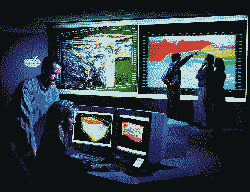What's happening in exploration
Marine production levels in land 3-D seismicThe first successful deployment of a new Vibroseis technique was achieved in late September 1998, by a 3-D seismic crew in the Sultanate of Oman. The slip-sweep technique, invented and promoted by Petroleum Development Oman (PDO), could be a significant breakthrough in on-land Vibroseis acquisition technology. The simple idea behind slip-sweep is to begin sweeping the next vibrator group without waiting for the current vibration to be completed, leading to a significant gain in productivity, particularly in open areas. Slip-sweep can be used for 2-D and 3-D seismic surveys to increase production or increase signal-to-noise ratio without a cycle-time penalty. The first experiment was conducted in 1995 by a Geco-Prakla crew who recorded uncorrelated salvos of two vibrator source groups with overlapping sweeps. Correlation and record separation, carried out at the processing stage, demonstrated that final slip-sweep sections were equivalent to conventional Vibroseis sections. One year later, by merging two 3-D crews, Rees Geophysical Oman conducted a slip-sweep logistics test. This was followed by CGG, which acquired slip-sweep field data in Makarem, recording eight vibration points (VPs) per salvo. These tests proved the feasibility of utilizing the slip-sweep technique on Vibroseis operations. In mid-1998, SERCEL announced a ready-to-use slip-sweep software option integrated within its SN388 24-bit acquisition system, using VE432 Vibrator electronics. In September 1998, installation of the new slip-sweep capability was carried out by a Veritas 3-D crew. One month after installation, the crew broke a PDO daily production record by recording 1,752 VPs in a 10-hr window, proving that slip-sweep capability brings Vibroseis land productivity to marine levels. The implementation of slip-sweep capability within a seismic acquisition system seems to be a good example of successful cooperation between an oil company, seismic contractors and equipment manufacturers to respond to a specific industry need. Visualize everything. Call them what you will: immersive environments, visualization theaters, reality rooms or virtual domes. If you are a geoscientist or an E&P manager who has not used such a display environment, you probably will soon. Silicon Graphics (SG) has been busy installing its supercomputers at two new visualization centers. These centers are ideal for co-displaying large volumes of seismic and other data types in a theater-like environment, fostering collaboration among exploration and production geoscience teams. The new Veritas visualization center is located in Houston and is powered by a SG Onyx2 RealityMonster supercomputer. The display is an 18´ 7-ft rear-projection viewing screen, and there are four private interpretation / visualization workrooms, allowing multiple teams to work simultaneously. According to Dale Bowering, vice president of business development, "A lot of ground can be covered quickly, producing results in a fraction of the time taken using conventional methods."
Statoil’s Advanced Visualization Center also opened for business last month. Landmark Graphics Corp. furnished its suite of integrated software, while SG supplied its Onyx2 supercomputer and an OpenGL Volumizer, an application interface that enables geophysicists to interactively roam through seismic data sets that can exceed 100 GB of data, and are more than 1,000 times larger than the previous limit of about 64 MB. Ability to interactively explore such immense amounts of data saves time and allows for greater accuracy in locating precious, hard-to-find petroleum reservoirs. A new era in collaborative computing was launched when Statoil linked its immersive visualization center in Stavanger, Norway, with a similar facility at Landmark’s Houston headquarters. Geoscientists at each location can work simultaneously on the same 3-D seismic data sets, with changes replicated at both sites in real time. Silicon Graphics will be hosting a Visualization and High Performance Computing Summit in Galveston, Texas, January 18–20, 1999. Sign of the times. When adjusted for inflation, the price of crude oil remains at a 50-year low. Petroleum Technology Transfer Council (PTTC) Chairman Robert Nance said, "Many believe (this crisis) is the most severe depression in decades." In response to the current low-price crisis affecting the E&P sector, PTTC announced it would structure "most, if not all, of its planned 1999 activities to address ‘survival’ needs of the industry." Known as the Industry Action Crisis Plan, PTTC regional technology workshops will focus on
survival methods, such as improving cost efficiencies and identifying "best practices"
for operating under economic-crisis conditions. Although technology has helped reduce
finding and producing costs, such costs are still too high to economically find or produce
oil in most regions of the U.S. PTTC will also compile a report concerning the effects of
the crisis on the U.S. petroleum industry. For more information, go to www.pttc.org, or call
1-800-843-7882. Copyright © 1999 World
Oil |
- Applying ultra-deep LWD resistivity technology successfully in a SAGD operation (May 2019)
- Adoption of wireless intelligent completions advances (May 2019)
- Majors double down as takeaway crunch eases (April 2019)
- What’s new in well logging and formation evaluation (April 2019)
- Qualification of a 20,000-psi subsea BOP: A collaborative approach (February 2019)
- ConocoPhillips’ Greg Leveille sees rapid trajectory of technical advancement continuing (February 2019)




